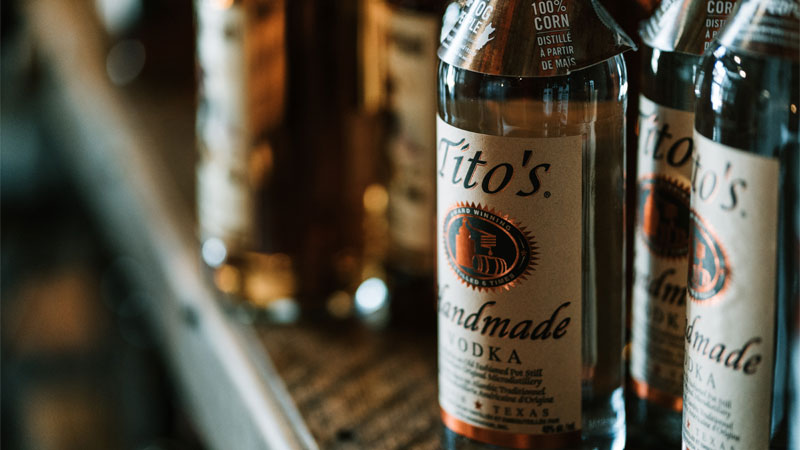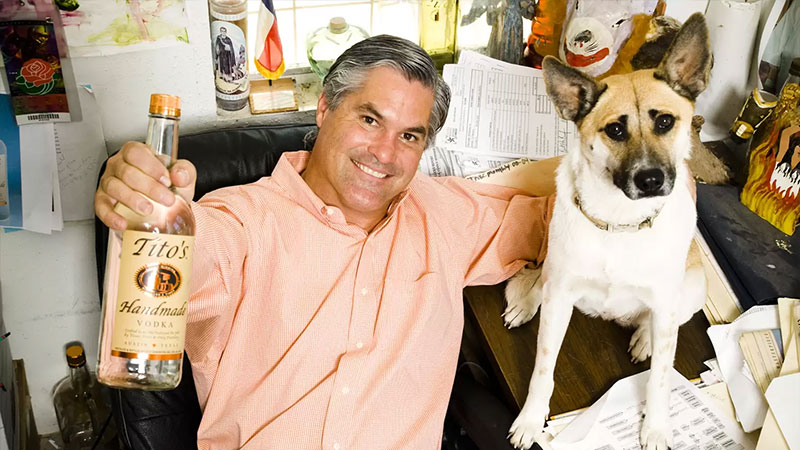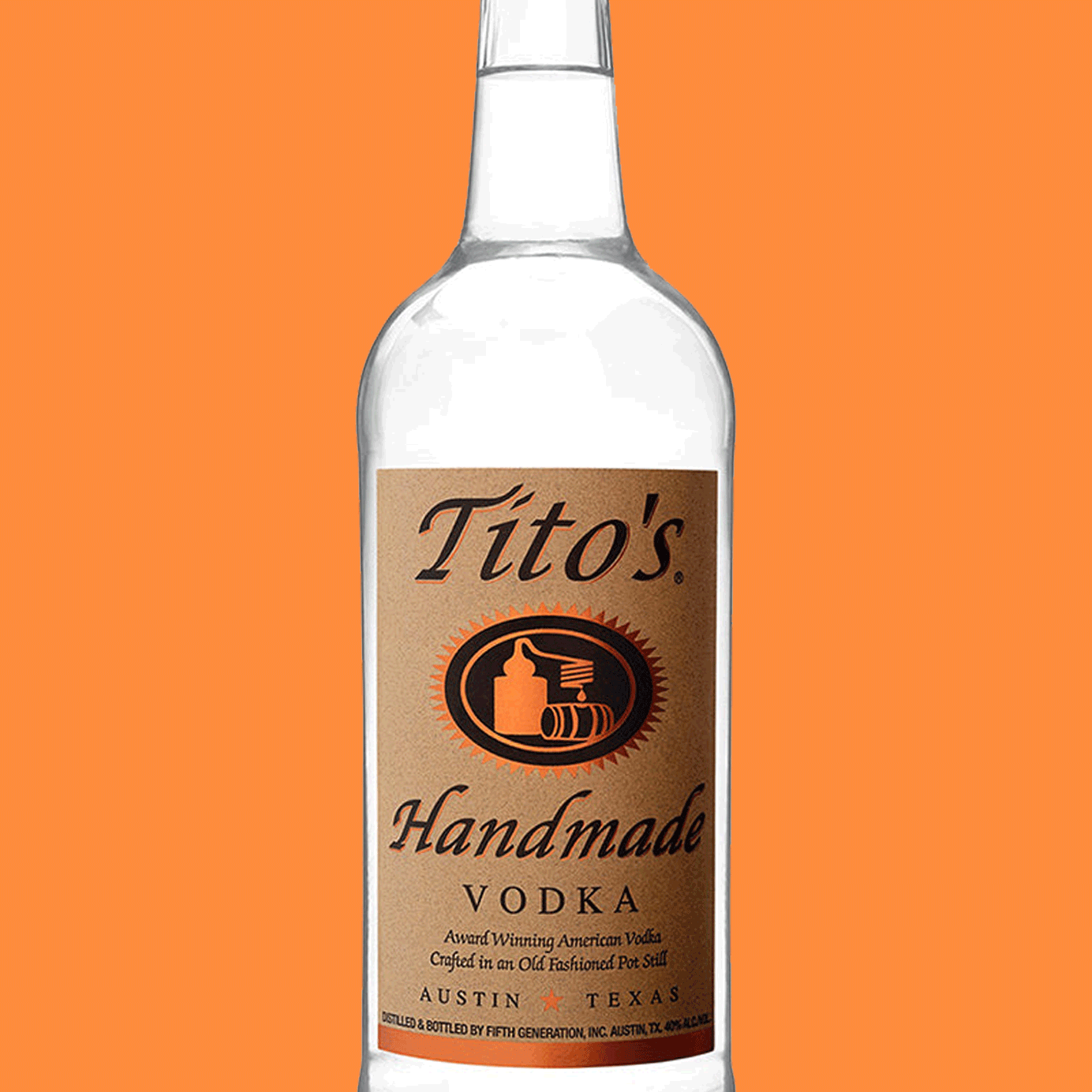I became a legal drinker in the year 2000 A.D. and it was also around that time I started seeing the no-frills bottles with kraft-paper labels featuring the silhouette of a pot still, its coil leading into a barrel. “Austin ★ Texas” was written in the fourth-largest font; “Vodka” was in the third. “Handmade” was even bigger than that. And the largest lettering offered the simple name: “Tito’s.”
Since 2017, Tito’s Handmade Vodka has been the best-selling overall spirit in America, moving over 10 million cases per year.
And no one seems to care that the brand is not exactly made in Austin, Texas, nor truly made with a pot still, or that it is absolutely, positively, 100 percent not handmade.
The Myth-Making
After graduating from the University of Texas, Bert Butler “Tito” Beveridge II became a successful then failed oilman, an environmental engineer for Superfund sites, and a mortgage broker, among other jobs. What he really enjoyed, though, he claims, was making habañero-infused vodka as presents for his friends.
Inspired by a late-night infomercial — whose? Who knows? Or was it actually a PBS show? — one day Beveridge decided to follow his passion in life, which in 1993, he thinks, was making his own vodka.
In 1995 he famously jury-rigged two Dr Pepper kegs and a turkey fryer into a sort of amateur pot still and began (illegally) distilling a corn-based vodka on some land south of what would soon become Austin–Bergstrom International Airport. He eventually became the first legally licensed distillery in the state of Texas, and by April 1997 he had sold his first bottle. By 2001 he had received a unanimous double gold medal at the World Spirits Competition. And the rest would seem to be history.

What’s interesting to me, however, is how Tito’s continues to be beloved based on all the things Beveridge did 25 years ago.
No longer is Tito Beveridge some scrappy entrepreneur who was couch surfing before he went into debt on 19 credit cards just to get his brand started; he’s a billionaire, the 354th richest person in the world, with a net worth nearing $6 billion.
No longer is Tito’s made in Austin with a scrapped-together pot still; it’s almost certainly produced by any number of grain-neutral spirit (GNS) factories throughout the country, with the best bet being Iowa’s Grain Processing Corporation or Illinois’ Archer-Daniels-Midland — in a Reddit thread from last year, anonymous users seem to confirm this.
“We would make it. Distill it 10 times … then send it to Tito’s in Austin so they can distill it one more time and say that they made it,” reports one man.
(Although, it would appear the labels are still hand-applied in Austin.)
No longer is it made using a pot still, either, despite the Tito’s website noting “we still make it in batches, use old-fashioned pot stills, and taste-test every batch to make sure you get only the best.” It is virtually impossible for a pot still to make such a clear and flavorless spirit, certainly in such massive quantities. (Multiple attempts to contact Tito’s went unanswered as of publishing time.) No, Tito’s can only be made by a column still. Sure, the distillate might be trucked back to Austin to be run through a pot still for mere legal sake, but it’s a column still that makes it.
The fact that most drinkers don’t understand how alcohol is made keeps the ruse going. The mainstream media, likewise unaware, are more than willing to carry Tito’s water as well.
(But, OK, yes, it is, in fact, still made with corn — the grain is cheap and subsidized by the government — and most of America’s grain neutral spirit is as well!)
Despite its tremendous growth and overall success, Tito’s still gets away with acting small and craft. How? One reason could be its crummy, unchanging label.
Ugly on Purpose
In my latest book, “Brand Mysticism,” Steve Grasse, the booze maven behind brands such as Hendrick’s Gin and Narragansett beer, talks about how, when he created Sailor Jerry Rum in 1999, he aspired to make the labels “ugly on purpose.”
“I think one big reason Sailor Jerry succeeded is that we intentionally made its packaging kind of shitty,” he claims. “It looks like it’s straight off the shelf of your grandpop’s basement bar.”
What Grasse means is it was clearly not designed to look trendy, using a clichéd hula girl tattoo that barely fit on the label, the lettering crammed beside it. You would have hardly thought it came from a century-old Scottish beverage giant.
Beveridge, meanwhile, designed Tito’s label himself, using the CorelDRAW graphics program on his home computer to craft that silhouette of his pot still. He selected the Lucinda Handwriting font as he thought it the “fanciest” available on the program — it looked like calligraphy. He called it “handmade” because it was indeed at the time, coming off a 16-gallon pot still he operated himself. To make his eco-friendly partner, Lori, happy, he went for that brown-ish recycled paper stock. And the lettering and logo have a burnt orange tinge because that’s the color of his alma mater — Austin’s beloved Texas Longhorns.
Indeed, I remember all the Texas expats living in New York in the early aughts gobbling up bottles of Tito’s as soon as they hit our market. Why buy the Swedish Absolut or Italian Skyy or Russian-ish Smirnoff when the Texas one was just as cheap and supposedly made by the man with his name on the label, not some multinational beverage conglomerate?

If Beveridge didn’t initially aspire to make his label ugly on purpose, the fact it remains ugly today — and they’ve never given it the glow-up they could afford — is clearly intentional.
That ugly label still resonates with people today. On Etsy, dozens of sellers offer customized Tito’s labels. Steve’s birthday, Alexandra’s graduation, Merry Christmas from Marie. For as low as $4.99, sellers will print your custom label on a similar kraft-paper stock, then you only need to slap it over top the normal label on your favorite vodka.
What other major booze brands have such a fandom?
Aw Shucks in Austin
Likewise, even if the vodka must initially be made in a factory somewhere else, Tito and Tito’s — the man and the brand — remain entrenched in Texas.
“There is still local pride for the brand,” says Wayne Alan Brenner, a longtime food, drink, and culture writer for The Austin Chronicle.
He thinks Beveridge very smartly laid a foundation for that early on, sponsoring countless concerts, theatrical events, art shows, and non-profit fundraisers in the early days, plastering the Tito’s logo and giving out complimentary vodka wherever he could. (Beveridge, who fancies himself a playwright, even self-funded a play he wrote in 2016.)
Today, Tito’s sponsorship for all-things-Austin is not as prevalent as it once was, but the brand is still a big force in the community. It offers the Tito’s Prize, a yearly $15,000 art grant and exhibition to an Austin-based artist, plants community gardens, supports local firefighters, and even rescue dogs. Tito himself has been gobbling up land in Austin and giving big donations to the university, making his Austin bonafides still evident.
All this visibility is surely to remind people that, even if Tito’s is the biggest booze brand in America, it’s not owned by some soulless corporation based in France or Italy or the Far East. It’s still owned by the man — now a very rich man — with his name on the bottle.
“Locals seem tickled by the company’s continued aw-shucks down-home stance,” says Brenner. “As if Tito himself is winking at us fellow Austinites while he takes over the world.”
This story is a part of VP Pro, our free platform and newsletter for drinks industry professionals, covering wine, beer, liquor, and beyond. Sign up for VP Pro now!
